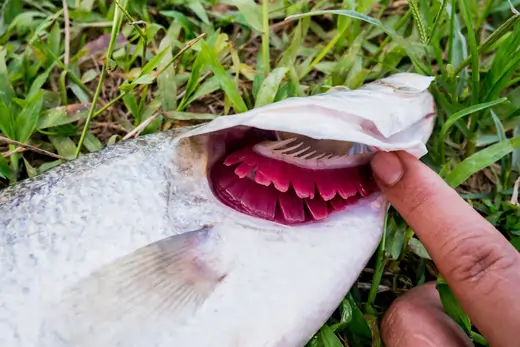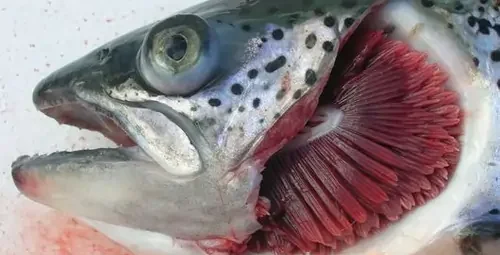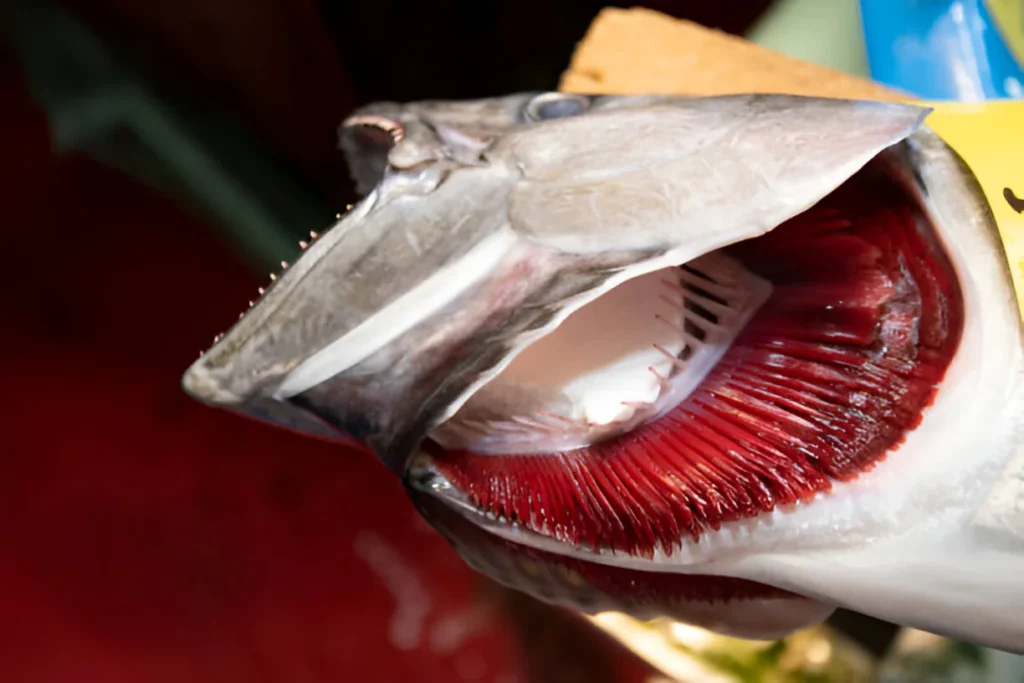Yes, fish gills are technically safe to eat, but they are not commonly consumed due to their texture and potential for harboring impurities. If you decide to eat them, make sure to carefully clean them first.
Fish gills, while often ignored, are a fascinating element of fish anatomy. You are not the only one who has asked if fish gills are safe to eat. With a growing interest in sustainable eating and decreasing food waste, more individuals are investigating different portions of fish that are commonly thrown. However, before adding fish gills to your plate, you should be aware of the health and safety risks associated with their consumption.
What Are Fish Gills?
Fish gills are the respiratory organs that help fish collect oxygen from water. These soft tissue structures, which can be found on either side of the fish’s head, resemble feathers. Gills serve an important function in the fish’s life cycle by regulating gas exchange, but when it comes to human eating, they must be carefully considered.
Fish gills have a soft and gentle texture, but they can also carry poisons or parasites if not properly cleaned or supplied. As a result, it is critical to fully grasp the risks and benefits before eating them.

Are Fish Gills Safe to Eat?
Yes, fish gills are generally safe to eat, as long as they originate from fresh, healthy fish and are properly prepared. Gills, like other sections of the fish, can be consumed in a variety of cultures, particularly in meals that use all of the fish. However, there are a few considerations to consider before adding them into your diet.
Fish gills can acquire pollutants depending on the water quality where the fish was caught. Consuming gills from wild-caught fish in dirty waterways may expose you to dangerous elements such as heavy metals, poisons, or parasites.
To reduce this risk, ensure that the fish are sourced from clean, uncontaminated water. Gills from farm-raised fish may have less contaminants, but always check the farm’s standards before eating.
Nutritional Benefits of Eating Fish Gills
While not the most popular portion of the fish, fish gills provide important nutrients. Gills are high in protein and include trace levels of omega-3 fatty acids, which are known to promote heart health, brain function, and inflammation reduction. Eating fish gills aligns with the concept of “nose-to-tail” eating, which promotes sustainability and reduces waste.
In some cultures, fish gills are considered a delicacy and are fried, grilled, or cooked in broths to extract their nutritional content. While they may not contain as many nutrients as fillets or livers, they do contribute to a more balanced fish diet.
Are Fish Gills Poisonous?
The question “Are fish gills poisonous?” is relevant. Fish gills are not naturally toxic. However, if the fish has been exposed to contaminated water or parasites, eating its gills may bring dangerous elements into your body. This is why it is vital to buy fish from reliable sources or catch them in clean, unpolluted waters.
Some fish species, such as pufferfish, have toxic components of their the body, but gills are not often among them. However, always check for area recommendations on which fish species are acceptable to consume and make sure the fish is thoroughly cleaned before consuming any part of it.

Side Effects of Eating Fish Head and Gills
While fish heads, including gills, are used in various cuisines around the world, there are possible negative effects to consider:
- Allergic Reactions: Some people may be allergic to fish proteins, including gills. If you are allergic to fish, avoid eating gills because they may cause symptoms.
- Heavy Metal Contamination: Pollutants such as mercury and other heavy metals can accumulate in the gills. Consuming poisoned gills may expose you to these poisons.
- Parasites: Fish gills may contain parasites or germs. Eating poorly cleaned or undercooked gills may result in infections or diseases caused by food.
While these problems may sound worrying, they are mainly avoidable with proper fish washing, cooking, and procurement.
Is Fish Gills Good for Cats?
If you are a pet owner wondering if fish gills are safe for cats, the answer is yes—but with caution. Cats can eat fish gills as part of a healthy diet, but the gills must be fresh and thoroughly cleaned. The gills, like those in humans, must come from fish that have not been exposed to dangerous toxins or pollution.
Cats love fish, and introducing components like gills can add variety to their diet. However, gills should be carefully boiled to eliminate the possibility of parasites. Avoid giving raw fish gills to your dogs since they raise the risk of bacterial infections and other health problems.

How to Remove Fish Gills Safely
If you want to prepare fish gills for consumption, you should first understand how to properly remove them. Here is a step-by-step instruction for safely remove fish gills:
- Prepare Your Tools: This method needs a sharp knife and a pair of kitchen scissors.
- Access the Gills: Hold the fish’s head steady and lift the gill cover, or operculum, to reveal the gills under.
- Cut Around the Gills: Using kitchen scissors, carefully cut around the base of the fish’s gills where they attach to the head. Be careful not to injure the surrounding tissues, especially if you want to boil the fish head whole.
- Remove the Gills: After cutting the gills, gently remove them out of the fish’s head. You may need to cut the remaining connective tissue to fully free them.
- Clean the Gills: Before cooking, clean the gills under cold running water to remove any residual blood or debris.
This process is easy to follow and provides you with clean, ready-to-cook gills.
Culinary Uses for Fish Gills
Fish gills can be used in a wide range of recipes from different cultures. Some of the most common culinary applications include:
- Fried Fish Gills: Fried fish gills are considered a delicacy in some cultures. They make an excellent snack or appetizer when lightly breaded and fried.
- Fish Gills in Broth: Gills are often added to fish soup to give it a richer taste. The gills break down and release nutrients into the soup, increasing its taste and texture.
- Grilled or Roasted: Gills are grilled or roasted in several parts of the world, which gives them a smoky, rich flavor that compliments spice mixture.
These preparations not only assist to prevent food waste, but they also give an interesting and spicy touch to your cooking expertise.
Risks and Considerations When Eating Fish Gills
When properly cleaned and cooked, fish gills are safe to eat. However, there are a few risks to consider.
- Contamination: Pollutants can collect on the gills as they filter water. Always make sure the fish is from clean, safe waterways.
- Bacteria and Parasites: Gills may contain bacteria or parasites, especially if the fish is not fresh. Cooking the gills completely can help reduce this possibility.
- Texture and Taste: Some people dislike the texture of gills, which can be chewy or slimy. If you are new to eating gills, start by frying them or cooking them in broth.
Conclusion
Are fish gills safe to eat? In short, yes—as long as they come from a clean environment and are properly cleaned and cooked. Fish gills, while unconventional, are a beneficial and sustainable choice that can give a distinct flavor to your meals. Gills can be a helpful addition to your diet if you know how to remove and prepare them properly. Gills, whether fried for a crunchy snack or used to intensify the flavor of a soup, provide an amazing culinary experience for anyone looking to discover new parts of the fish.
https://www.profitableratecpm.com/p6gteabyj6?key=a8baca7d20bd4e03b2c0f81360552304
FAQs
Are fish gills nutritious?
Yes, fish gills contain proteins and small amounts of omega-3 fatty acids, but they are less nutrient rich than other parts of the fish.
Can you get sick from eating fish gills?
You may get ill if the fish gills are contaminated with pollutants or are not cleaned and cooked correctly. Make sure your fish comes from trusted suppliers.
Do different fish species have safer gills to eat?
In general, the safety of gills is more dependent on water quality and fish handling than on the species. However, particular fish are more prone to collecting poisons in their gills due to their environment.
How do you clean fish gills before eating?
To clean fish gills, remove them from the fish’s head and completely wash them with cold water to remove any blood, debris, or pollutants.
Are fish gills good for making stock?
Yes, fish gills can add a deep, umami taste to fish stocks and broths, making them a great ingredient for soups and stews.
Can fried fish gills be eaten on their own?
Absolutely! Fried fish gills are a favorite delicacy in several cultures, usually served crispy with a light breading.


